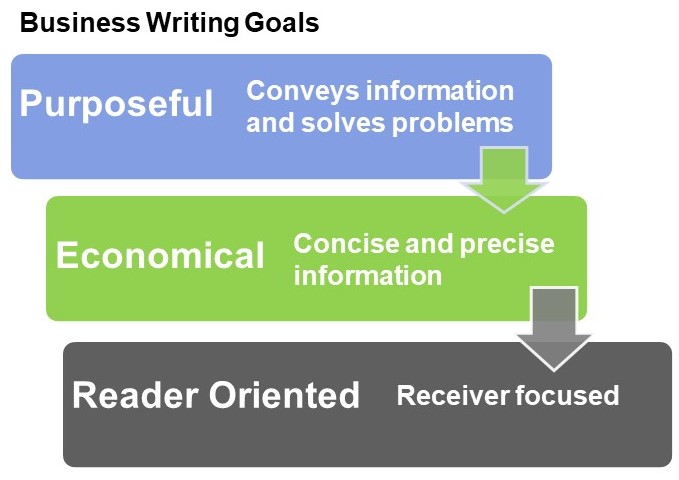3.1 Knowing Your Purpose for Writing
Learning Objectives

After studying this unit, you will be able to
-
-
- distinguish between general and specific purposes for writing
- understand the Writing Process
-
Introduction

Rarely does anyone write for professional reasons just for fun. There must always be a good reason for writing an email, filling out a work order, or composing a large market research report. Knowing your reason for writing is essential to staying on track in the writing process. Business communications has three main reasons: to inform, to persuade, and to communicate goodwill.
Whatever the purpose of your document, business writing is not intuitive. Thus, the next four chapters will present a systematic plan for preparing business messages in the digital age: pre-writing, drafting, and revising, called the 3-x-3 Writing Process. The process starts with knowing the purpose of the message, which will guide you towards writing an effective message in a document appropriate for the audience and occasion.
The Writing Process
Overview
The writing process follows a three-phase process: pre-writing, drafting and revising (see Figure 4.1). The time you will spend in each phase will depend on the complexity of the problem, the purpose and the audience. Business writing differs from other forms of writing. Instead of long paragraphs that fully develop arguments, business writing is focused, clear and concise. In the workplace, writing should be purposeful, economical, and reader-oriented. Writing this way is a skill that takes time and practice to develop. Carefully working through the Writing Process is the key to perfecting this skill.

Pre-writing: Phase I of the writing process involves analyzing the audience. Messages must provide receivers with the information they need or want to be informed or persuaded. Anticipating audience reaction is also part of this phase: will the audience have a positive, negative, or neutral response to the message. A writer must understand these factors and adapt the message to communicate clearly with the intended audience.
Drafting: Phase II of the writing process involves, researching, organizing, and then drafting the message. What information is most important to the receiver is at the heart of each part of this phase. This phase in the writing process is critical to preparing a final document that meets audience needs.
Revising: Phase III involves editing, proofreading and evaluating the message to ensure the message accomplishes the goal of communication.
Key Takeaways

-
-
-
- Business communication has three purposes: to inform, to persuade, and to promote goodwill. Knowing the purpose for writing at the outset helps keep you on track with topic selection.
- The three phases of the Writing Process: pre-writing, drafting, and revising, is a systematic way to make the writing process quicker and easier.
-
-
Exercises 4.1
 Select a letter you’ve recently received in the mail (or one your roommate, friend, or family member has received) from a company or organization, ideally a promotional or campaign letter rather than one too specific to your own or the recipient’s situation, and describe both its general and specific purposes. If its general-purpose included informing (recall that a document can have more than one general purpose), identify the subtopics (5 W’s + H).
Select a letter you’ve recently received in the mail (or one your roommate, friend, or family member has received) from a company or organization, ideally a promotional or campaign letter rather than one too specific to your own or the recipient’s situation, and describe both its general and specific purposes. If its general-purpose included informing (recall that a document can have more than one general purpose), identify the subtopics (5 W’s + H).
Reference
Bovee, C.L., Thill, J. V., & Scribner J. A. (2016) Business communication essentials (4th ed.). Don Mills, ON: Pearson Canada Inc.
Guffey, M., Loewry, D., & Griffin, E. (2019). Business communication: Process and product (6th ed.). Toronto, ON: Nelson Education. Retrieved from http://www.cengage.com/cgi-wadsworth/course_products_wp.pl?fid=M20b&product_isbn_issn=9780176531393&template=NELSON
Providing the necessary information to help receiver make decision or solve problem.
Convince the receiver to take a recommended course of action.
Ensures the receiver walks away with a good opinion of the sender of information

